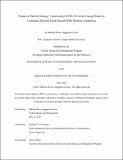Product to Platform Strategy: Transitioning COVID-19 Citizen Tracing Product to Centralized Personal Health Record (PHR) Platform in Indonesia
Author(s)
Listyo, Sabrina Woro Anggraini
DownloadThesis PDF (2.203Mb)
Advisor
Cusumano, Michael A.
Terms of use
Metadata
Show full item recordAbstract
Institutions are increasingly realizing the importance of transitioning from stand-alone digital products to platform-based models. This shift presents several challenges, as platforms need to build an ecosystem that involves multiple third-party partners. This study examines the Satu Sehat app (“Healthy United” in Indonesian) application from the Indonesian Ministry of Health. It serves as a health service platform that enables citizens to access their Personal Health Records (PHR) and improve the patient’s journey. The app evolved from a stand-alone digital product, the previous national COVID-19 tracing app, Peduli Lindungi. Satu Sehat Mobile platform has a unique model compared to other commercial platforms developed by private companies, as it is created by a government institution, the Digital Transformation Team (DTO) from the Ministry of Health. As a result, its key metrics and success factors differ from those of commercial platforms. Through a combination of literature review and interview with the platform development team, this thesis explores why a product should evolve into a platform, what key factors drive a successful transition from product to platform, and how platform owners can effectively collaborate with third-party complementors. One key advantage of a platform-based model is the potential to create network effects, where the value of the platform increases as more users and third-party complementors join and interact with it. Effective collaboration with third-party complementors is also critical to the success of a platform-based model. This involves providing the necessary tools and resources to enable complementors to build on the platform and monetize their services. Drawing from the thesis findings, institutions can better assess whether adopting a platform-based model is necessary to remain competitive and relevant in today's market.
Date issued
2023-06Department
System Design and Management Program.Publisher
Massachusetts Institute of Technology